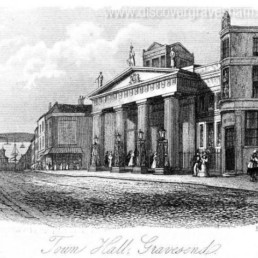Gravesend Old Town Hall
Discover why Gravesham’s coat of arms has a mysterious blue porcupine, and how it inspired Edward Lear to write ‘The Owl and the Pussycat’.
Choose the Instagram or Facebook button below to open the AR experience.
Focus your camera on the mural itself or an image of the mural to see if come to life.
This experience will open your camera feed. Turn your sound on to enjoy the full experience.
History
Although the porcupine is native to Africa and the Americas, it’s been part of the Gravesham coat of arms since Medieval times. Today’s coat of arms was designed in 1975. It shows a sea porcupine with the body of a porcupine and the tail of a fish facing the white horse of Kent.
Porcupines are a symbol of invincibility in France and King Louis XII adopted it as his personal emblem. In the 16th century the Sidney family of Penshurst Palace added the porcupine to their crest, likely due to their connection to King Louis.
Sir Henry Sidney regulated the barges and boats on the Thames in the mid 1500s and likely influenced the first Gravesham coat of arms leading to the inclusion of the porcupine. Created in around 1568, it showed a land porcupine with four legs and a chain around its neck at the helm of a ship. You can still see it here in the mosaic, on the gate of the Milton Chantry, and embroidered on banners at St Andrew’s Church.
The hooded rowers are likely an allusion to Richard II’s decree that the people of Gravesend should be the only people allowed to row passengers from Gravesend to London in repayment for the plundering of Gravesend by French forces who were undetected by Richard II’s warning beacons. This journey up the Thames was known as the ‘long ferry.’
The modern Gravesham coat of arms is said to have inspired Edward Lear’s nonsense poem ‘The Owl and the Pussycat’ as his father Jeremiah lived in Gravesend and was buried in Milton Churchyard in 1833.

